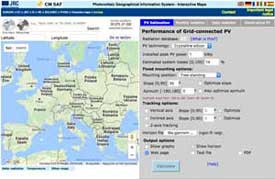Content – Energy generation
Direct conversion of light into electricity.
Materials absorbing photons and being ionized such that electrons are released are known to have a photoelectric effect, often called solar cells. When the free electrons released are captured, electric current is the result.
Solar cells are made of semiconductor materials such as silicon (wafers) or non-silicon materials such as cadmium telluride, treated to form an electric field, positive on one side and negative on the other. Due to the semiconductor structure the electrons are forced in one direction creating the current. The current produced is directly dependent on how much light that strikes the module.
Crystalline silicon (c-SI)
Simplified crystalline silicon photovoltaic cell (not to scale)
N-Type Silicon (Negative)
N-type silicon has been chemically combined with phosphorus gas to make it conductive. A silicon atom has four electrons in its outer shell and bonds tightly with four surrounding silicon atoms creating a crystal matrix with eight electrons in the outer shells. Phosphorus has five electrons, and when combined, the fifth electron becomes a “free” electron that moves easily within the crystal when a voltage is applied. Since the charge carriers are electrons, n-type refers to a negative charge.
P-Type Silicon (Positive)
P-type silicon is combined with boron gas making it a conductive material that accepts electrons when voltage is applied. Boron has three electrons in its outer shell and can bond with only three of the four surrounding silicon atoms. This leaves one silicon atom with a vacant location in its outer shell, called a “hole,” that accepts one electron. Since the charge carriers are holes, p-type silicon is said to have a positive charge.
The amount of sunlight and the number of wafers will determine cureent and voltage generated. Solar cells generate direct current (DC). The typical voltage produced from a single silicon based photovoltaic cell would be 0,3 – 0,6 volt (V)
Efficiency of silicon based solar cells
The efficiency of solar cells is not 100% since some of the light spectrum is reflected, some is too weak to generate electricity (infrared) and some (ultraviolet) creates heat instead of electricity.
Monocrystallin cells operate with an efficieny of 15%- 20 %.
Multicrysatalline cells are less costly to manufacture but are a little less efficient, 12% -16%.
Thin film solar cells
Amorphous silicon (a-Si)
Simplified amorphous silicon photovoltaic cell (not to scale)
Amorphous silicon (a-Si) is the non-crystalline form of silicon.
The cell structure has a single sequence of p-i-n layers (“i” = intrinsic layer).
A-SI type thin film solar cells are commonly found in calculators and other small electronic devices.
Thin film silicon solar cells operate with an efficiency of 6% – 10% but consume less material and have a high degree of flexibility in application compared to the traditional wafer based PV cells.
Cadmium Telluride (CdTe) solar cell
Simplified cadmium telluride photovoltaic cell (not to scale)
CdTe solar cell is the most common photovoltaic (PV) technology next to crystalline silicon.
CdTe cells have a thin layer of cadmium telluride and are normally coated with cadmium chloride (CdCl2) to increase the efficiency.
The CdTe thin-film solar cell is a cost efficient alternative to conventional silicon based cells. The manufacturing of the cells can be efficient and relatively inexpensive.
The average module efficiency of the CdTe thin film solar cell is around 16%.
Copper Indium Selenide (CIS) and Copper indium Gallium diSelenide CIGS Solar cell
Simplified copper indium selenide and copper indium gallium deselenide photovoltaic cell (not to scale)
CIS cells have a thin layer of CuInSe2 ,on glass or metal backing.
A common variation of this cell is the copper indium gallium diselenide CIGS cell.
CIS cells have up to 14% efficiency and since they are thin film, they can be less costly than silicone based cells.
Capacity
Normally the capacity of a photovoltaic system is given as Wp (Watt – peak) based on standardised test conditions.
As a general “rule of thumb” a 1kWp system would have a size of 5 -10 m2.
Average annual production for a standard 1 kWp system at some selected locations:
North Scandinavia: 700 – 800 kWh/year (kilo watt hours/year)
South Scandinavia: 900 – 1200 kWh/year
South of Spain: 1700 – 1800 kWh/year
Sahara: 2200 – 2300 kWh/year
Calculate the potential of using photovoltaic energy generation.
The below hyperlinks brings you to free, third party calculators that can provide preliminary data and details related to potential Solar PV cell applications.
The calculators take into consideration various types of photovoltaic technologies and mounting options, solar potential at all locations within the territory and further have several options for optimization and variations to suit actual conditions.
PVGIS Calculator
The PVGIS calculator for Europe, Africa and parts of Asia is provided by the European Commission Joint Research Centre.
Calculator for Europe, Africa and Asia
PVWatts calculator
The world wide PVWatts calculator is provided by NREL, the national laboratory of U.S Department of Energy, Office of Energy Efficiency and Renewable Energy, operated by the Alliance for Sustainable Energy, LLC
Please be noted that all use of the above tools and the use of any information contained in or derived from the tools is at your own risk. Neither Energyfaculty.com nor the the provider of the tools makes any warrant, express or implied of merchantability and fitness for a particular purpose or assumes any legal liability or responsibility for the accuracy, completeness, or usefulness of any information provided by or derived from the tools, or represents that its use would not infringe privately owned rights.

